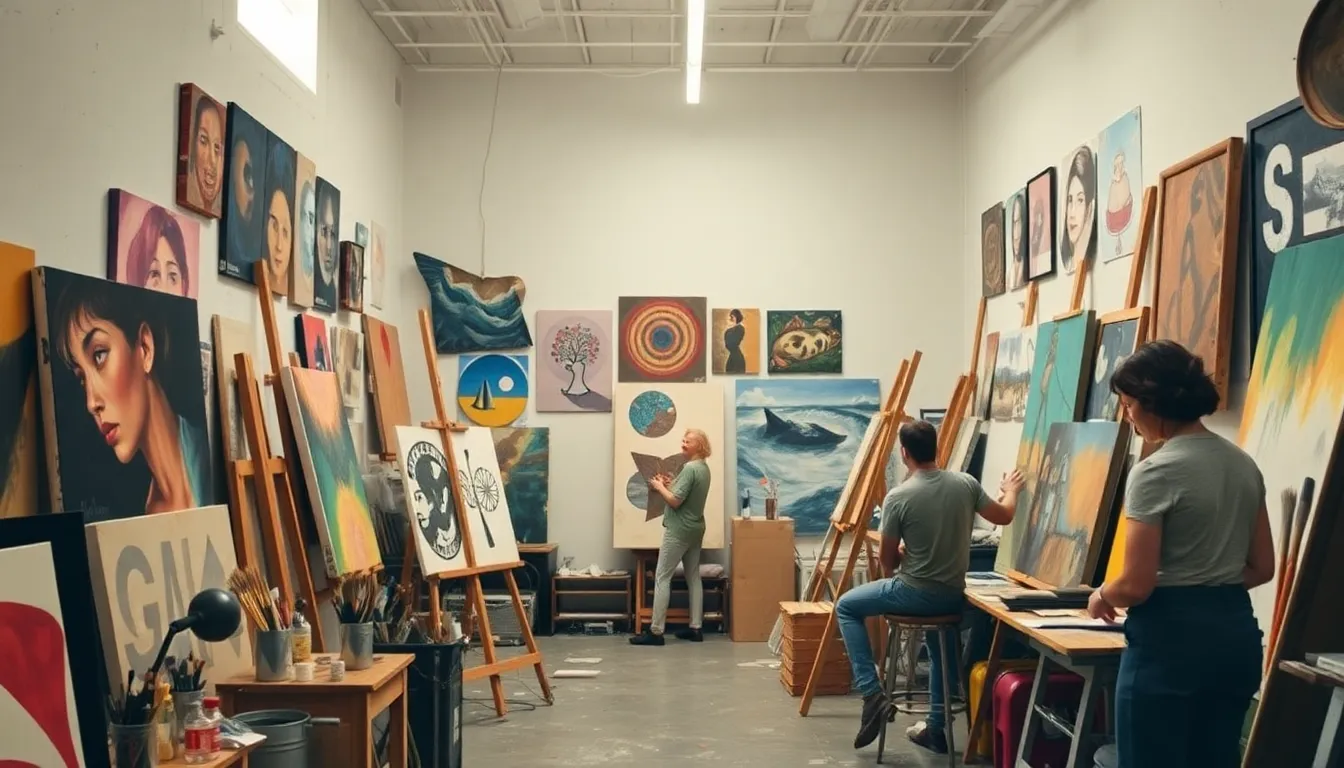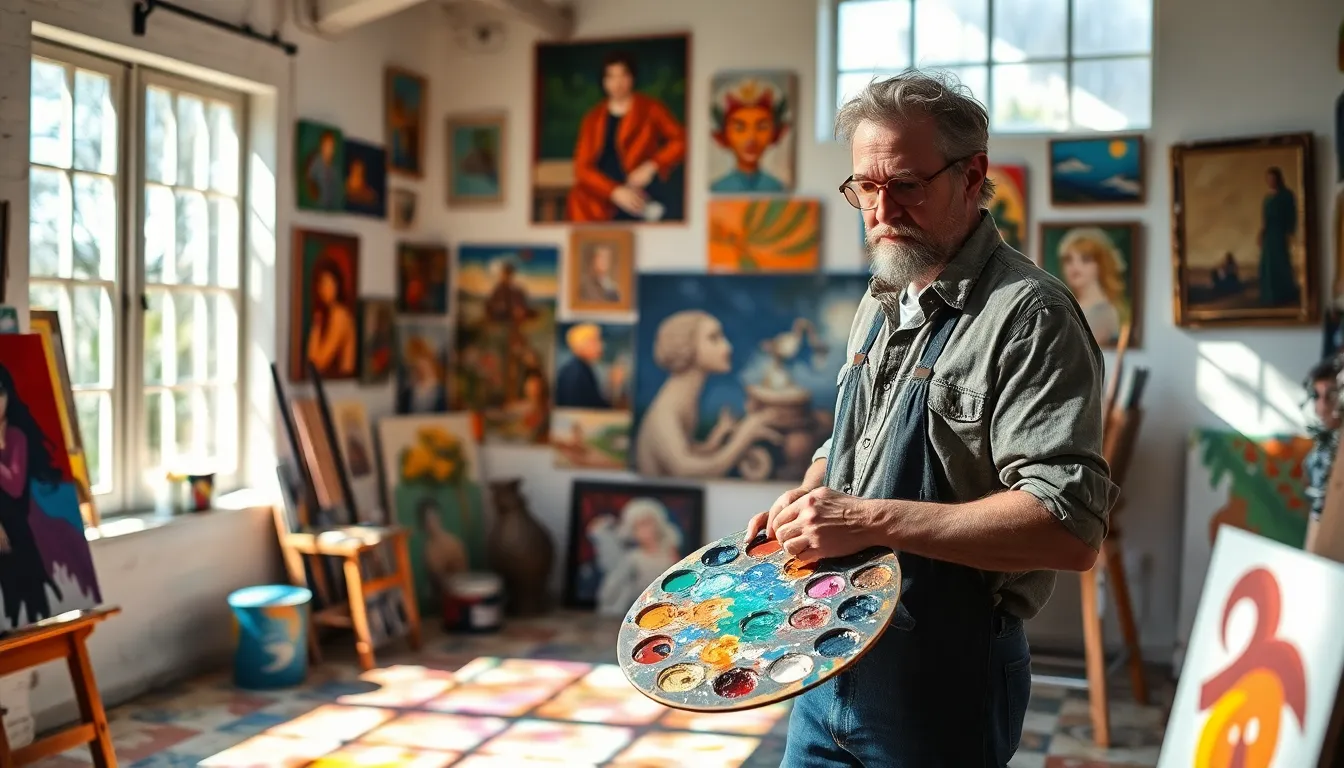Table of Contents
ToggleArtistic approaches are like the secret sauce in a chef’s kitchen—without them, creativity can taste a bit bland. From the bold strokes of abstract expressionism to the meticulous details of realism, each method offers a unique lens through which to view the world. Artists don’t just create; they invite us on a journey, challenging our perceptions and tickling our imaginations.
In a world filled with cookie-cutter solutions, embracing diverse artistic techniques can spark innovation and inspire fresh ideas. Whether it’s through painting, sculpture, or digital media, these approaches breathe life into the mundane and transform the ordinary into the extraordinary. So, buckle up as we explore the delightful chaos and structured beauty of artistic methods that might just make you rethink how you see art—and maybe even the world around you.
Overview Of Artistic Approaches
Artistic approaches encompass a wide array of techniques and styles that artists employ to express their ideas and emotions. Each method offers unique perspectives, enriching the overall experience of both the creator and the observer. Abstract expressionism emphasizes spontaneity and emotional intensity, while realism focuses on lifelike representation and detail.
Numerous styles exist, including impressionism, which captures the effects of light and color, and cubism, known for its fragmented forms. These approaches serve not only as technical frameworks but also as avenues for storytelling. Through art, individuals can communicate complex narratives that resonate on multiple levels.
Artists often blend techniques, merging aspects of different styles to create innovative results. Such experimentation fosters growth and allows for personalized expression. In digital media, artists explore new possibilities by integrating technology with traditional methods, pushing boundaries further.
Collaborative projects often highlight the power of diverse artistic approaches. When artists from varied backgrounds come together, they produce works that challenge conventional perceptions and provoke deeper thought. Each contribution enriches the final piece, illustrating the importance of diversity in art.
Critics and historians study these approaches to understand their cultural and historical contexts. Their insights help frame the significance of various movements within the artistic landscape. Ultimately, exploring artistic approaches reveals the interplay of skill, emotion, and perception that define the human experience through art.
Historical Context

Artistic expression has continually transformed through various historical movements. Each approach reflects its unique cultural, social, and political influences.
Early Artistic Movements
Renaissance artists introduced techniques such as perspective and chiaroscuro, emphasizing realism. Baroque style followed, marked by drama and vivid detail. Impressionists later shifted focus to light and color, capturing fleeting moments. These movements laid the foundations for exploration beyond traditional representation. They fostered an atmosphere where emotion and individual expression gained significance. In turn, these early approaches set the stage for modern trends.
Evolution Through Time
As society evolved, so did artistic approaches. The 20th century witnessed the rise of abstract expressionism, which emphasized spontaneity and emotional depth. Subsequent movements like Surrealism and Cubism challenged conventional perceptions, inviting experimentation. Digital art emerged in the late 20th century, blending technology and creativity. Artists began using innovative tools to create immersive experiences. With each era, these evolving styles reflect shifting societal values and technological advancements that shape artistic expression.
Types Of Artistic Approaches
Artists utilize various approaches to express creativity, each contributing uniquely to the art world. Understanding these types enhances appreciation for their work.
Traditional Techniques
Traditional techniques encompass methods like painting and sculpture, rooted in history. Artists leverage oil painting to achieve depth and texture, often using fine brushes for detailed work. Additionally, watercolor allows for a delicate blending of colors, creating soft transitions. Ceramics remains popular, showcasing skill in shaping and glazing clay. Techniques such as printmaking provide distinct methods for reproduction, emphasizing craftsmanship. Traditional approaches emphasize cultural heritage and established skills, inviting viewers to connect with historical contexts and narratives.
Contemporary Practices
Contemporary practices reflect modern influences and innovations in art. Digital media thrives through tools like graphic design software and animation programs, allowing endless creativity. Mixed media encourages artists to combine various materials, including found objects and photography. Installation art offers immersive experiences, challenging spatial dynamics in galleries. Artists often explore social issues by incorporating performance art, engaging audiences in thought-provoking ways. This diverse landscape showcases how contemporary practices expand the boundaries of artistic expression, fostering conversations about identity, culture, and society.
The Role Of Technology
Technology significantly transforms artistic practices, integrating new dimensions into creative expression. Artists harness digital tools to create innovative art forms that challenge traditional boundaries.
Digital Art Forms
Digital art encompasses various disciplines, including digital painting, 3D modeling, and animation. Artists utilize software like Adobe Photoshop and Blender to produce visual works that never existed in the physical realm. With advancements in virtual reality and augmented reality, creators immerse audiences in interactive experiences, enhancing engagement and exploration. Platforms like Instagram and Behance allow artists to showcase their work and connect with global audiences instantly. The rise of NFTs represents a shift in ownership and value, redefining how art is bought and sold in the digital landscape.
Impact On Traditional Methods
Technology influences traditional artistic methods, blending old techniques with modern innovations. Painters incorporate digital elements into canvases, enhancing texture and color vibrancy. Printmaking has adapted to include digital printing techniques, allowing for greater precision and versatility. Sculptors use 3D printing to create intricate designs, expanding what’s possible in physical form. Traditional and contemporary practices coexist, enriching the artistic dialogue and offering fresh perspectives. As technology evolves, artists constantly explore its potential, leading to groundbreaking artistic developments.
Artistic approaches play a pivotal role in shaping creativity and perception. By exploring various styles and techniques, artists invite audiences into a rich tapestry of emotional and intellectual experiences. The fusion of traditional and contemporary practices not only expands artistic boundaries but also fosters meaningful dialogue about identity and culture.
With technology continually transforming the landscape, artists are empowered to innovate and connect with viewers in unprecedented ways. This evolution encourages a deeper understanding of art’s role in society, reminding us that the journey of artistic expression is as vital as the final creation. Embracing diverse approaches ultimately enriches the human experience, inspiring future generations to explore the limitless possibilities of art.




